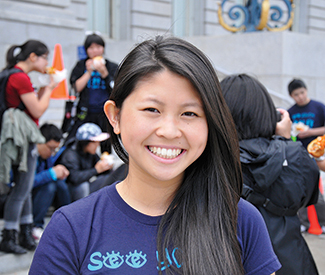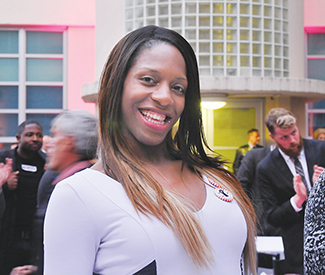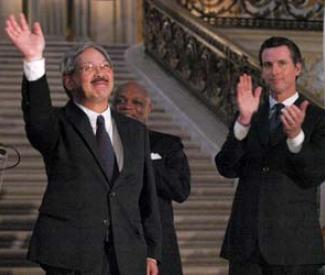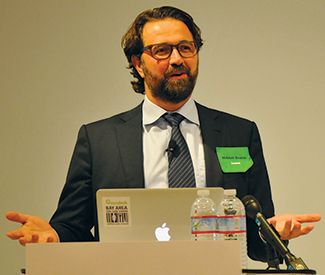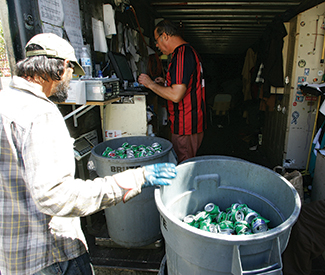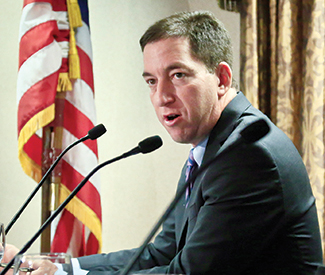rebecca@sfbg.com
“I am a survivor of the AIDS epidemic,” Daniel volunteered, beginning to tell us his very San Francisco story.
He was diagnosed with HIV in the 1980s. Working in fine dining rooms of San Francisco hotels at the time, he had health insurance, and had gone to Kaiser for an unrelated procedure. That led to a blood test — and then wham.
“They just bluntly, without any compassion, just told me: You have it,” Daniel said. “Like telling you that you have a pimple on your nose or something.”
All around him, friends were dying from the disease. “I didn’t freak out, because that’s just my personality,” he recalled. “I know a lot of people who have been diagnosed, and they want to take their lives or whatever.”
Today, he’s unemployed and living on a fixed income. He lost his left eye years ago to an infection linked to HIV; he now has a prosthetic eye.
“I’m single, disabled, and low-income,” reflected Daniel, who didn’t want his last name printed due to privacy concerns. Originally from El Salvador, his family came to the U.S. when he was 10 and Daniel has permanent resident status. But despite the disadvantages he faces, Daniel still isn’t freaking out. His medical needs are met.
He got on MediCal after having to drop Kaiser. “And then I ended up at SF General,” he said, “with some of the most professional staff, doctors rated worldwide. It has some of the most professional health care providers for HIV, all in one place.”
Daniel is one satisfied San Francisco General Hospital patient, and he might as well be a poster child for how public health is supposed to work in big cities. Rather than being deprived of primary care and then showing up at the emergency room with preventable complications stemming from his disease, he’s keeping everything in check with regular doctor’s visits — and he can access this high level of care even though he’s on a very tight budget.
There’s a concerted effort underway in the San Francisco Department of Public Health to give more patients precisely the kind of experience Daniel has had, while also expanding its role as the region’s go-to trauma center.
But a difficult and uncertain road lies ahead of that destination, shaped in part by federal health care reform. The new course is being charted amid looming financial uncertainty and with more patients expected to enter the system and the doors of SF General.
Not every General Hospital patient is as lucky as Daniel. For scores of others, SF General is the last stop after a long, rough ride.
EMERGENCY CARE
Craig Gordon and Dan Goepel drive an ambulance for the San Francisco Fire Department, regularly charging through congested city streets with sirens blaring as they rush patients to SF General and other care facilities. They see it all: Patients who are violent and psychotic and need to be restrained in the back of the ambulance, folks who’ve just suffered burns or gunshot wounds.
Sometimes, in the thick of all of this, SF General’s Emergency Department is closed to ambulances — in public safety lingo, it’s called being “on diversion” — so the medics will have to reroute to different hospitals.
SF General might go on diversion because the Emergency Department is too slammed to take on anyone new, or because it’s too short-staffed to take on new patients without pushing nurse-to-patient ratios to unsafe levels.
For serious trauma cases, strokes, heart attacks, or traumatic brain injuries, however, the doors are always open. Patients with less-serious cases are the ones to be turned away when the hospital is on diversion.
Patients who wind up en route to SF General in Gordon and Goepel’s ambulance might be living on the margins. “If you’re kind of living on the cusp … you’re not likely going to pursue getting a primary care physician,” Goepel pointed out. “When something comes up, then you find yourself in the emergency room.”
Or their patients might be getting rescued from a spectacularly awful situation, like a plane crash. In this densely populated, earthquake-prone region, there is only one top-level trauma center between Highway 92 and the Golden Gate Bridge: SF General. Anyone in the city or northern San Mateo County unfortunate enough to experience a life-threatening incident — a car wreck, shooting, nasty fall, boating accident — winds up there, regardless of whether they’re rich or poor, indigent or insured. Ranked as a Level 1 trauma center, SF General is equipped to provide the highest level of care.
“In the summer, when school is out, we have a high season of gunshot wounds and stab wounds,” explained Chief Nursing Officer Terri Dentoni, who recently led the Guardian on a tour of the Emergency Department. “When it’s really nice outside, you have a lot of people who get into bike accidents, car accidents. … Last week, we were just inundated with critical care patients.”
Around 100,000 patients flow through SF General’s doors each year, and more than 3,900 need trauma care. On July 6, 2013, when Asiana Airlines’ Flight 214 crash-landed at San Francisco International Airport, more than 60 crash victims were rushed to SF General with critical issues ranging from organ damage to spinal injuries.
“It was a very big tragedy,” Dentoni said. “But it was amazing how many people we took care of, and how well we took care of them.”
Aside from being the sole trauma center, SF General is also designated as the county’s safety-net hospital, making it the only healthcare option for thousands who are uninsured, poor, undocumented, homeless, or some combination thereof. This makes for complex cases. Patients might require translators, be locked in psychiatric episodes, or need a social worker to help them get to a medical respite facility after being discharged if they’re too weak to fend for themselves and don’t have anyplace to go. There isn’t always a place to send them off to.
“We’re seeing people who are dealing with poverty, and often homelessness, in addition to mental health issues,” explained Jason Negron, a registered nurse in the Emergency Department. “You’re seeing patients who often have a number of things going on. Someone who has multiple illnesses — HIV, heart failure, Hepatitis C — even under the best of circumstances, they would be juggling medications. So what happens when they’re out on the streets?”
San Francisco ranks high on the list of health-conscious cities, a haven for organic food aficionados, yoga addicts, and marathon runners. It’s also a world of high stakes struggles and mounting economic pressures. With the city’s skyrocketing cost of living, sudden job loss can spell disaster for someone without a financial cushion. SF General is the catchall medical care facility for anyone who’s slipped through the cracks.
But while rank-and-file hospital staff must tackle grueling day-to-day problems, like how to juggle multiple patients with complex health issues when all the beds are full and the hospital is understaffed, hospital administrators face an altogether different challenge.
For the past several years, the city’s Department of Public Health has been preparing for the implementation of the Affordable Care Act, aka Obamacare, the federal policy that is reshaping the health care landscape. Since public hospitals are mandated to provide safety-net care, they are uniquely impacted by the ACA.
Even with a sweeping new rule mandating health insurance for all, some segment of the population will nevertheless remain uninsured. But they’ll still need medical care — and when health crises come up, they’ll turn to SF General. Trouble is, no one knows exactly how much funding will be available to meet that need as the financial picture shifts.
FUNDING CUTS LOOM
Even as ACA aims to increase access to medical care, it’s also going to trigger major funding cuts at the local level. With both state and federal funding being slashed, San Francisco’s county health system stands to lose $131 million in financial support over the next five years, a budgetary hit totaling around 16 percent.
That’s a significant shortfall that will directly impact SF General — but the cuts are being made with the expectation that these gaps will be filled by reimbursements riding in on the waves of newly insured patients enrolled in ACA. Before federal health care reform took effect, around 84,000 San Franciscans lacked health insurance. At the start of this year, 56,000 became eligible to enroll in a health insurance plan.
SF General serves most of the area’s MediCal patients, the subsidized plan for people living on less than $16,000 a year. And since the county gets reimbursed a flat rate for each patient, the expansion of MediCal under federal health care reform will presumably help San Francisco absorb the state and federal funding losses.
“There’s a certain set of patients who previously were not paid for, who now will have MediCal,” explained Ken Jacobs, an expert in health care policy and professor at the UC Berkeley Labor Center.
But there’s a catch. Since MediCal and insured patients will be able to choose between San Francisco’s public system (called the San Francisco Health Plan) and a private medical provider, SF General also runs the risk of losing patients. If too many decide to go with Anthem Blue Cross instead, the system could veer into the red.
“There’s some question of what share of those we’ll keep,” Jacobs noted.
Asked about this, hospital CEO Sue Currin sounded a note of confidence. “Because our outcomes and our quality of care has been so high…75 percent of everyone who’s enrolled in MediCal managed care default to the Department of Public Health,” she told us.
But the journey toward ACA has only just begun, and things are still falling into place. Costs are projected to rise if nothing is done to improve efficiency, while at the same time, the pending state and federal funding shortfalls could take a toll.
Retaining and attracting insured patients is the only way to avoid a resource crunch — but patients could always walk away if they’re dissatisfied. This uncertainty “makes financial planning and management of risk even more challenging,” according to a report issued by the City Controller.
“We don’t know yet today how the Affordable Care Act will impact the safety net,” acknowledged Erica Murray, CEO of the California Association of Public Hospitals, which represents 21 public safety-net institutions throughout the state. “How are these health care systems evolving to be competitive? How do we continue to fulfill our core mission of being the safety net? That is the fundamental challenge. And we don’t know today, and we can’t be certain, that these public health systems will have sufficient funding.”
It’s all “very dynamic,” Murray said. “We don’t have sufficient data to be able to draw any definitive conclusions. It’s just too short of a time to be able to make any predictions. It will take several years.”
For all the newly insured patients under ACA, a certain segment will continue to rely on the safety net. Undocumented immigrants who don’t qualify will be left outside the system. Some individuals can be expected to outright refuse ACA enrollment, or be too incapacitated to do so. Others will opt out of Covered California, the ACA plan for people who make more than about $29,000 a year, because their budgets won’t stretch far enough to afford monthly payments even though they technically qualify. They’ll need safety-net care, too.
Yet under the new regime, “We can’t, as a safety net, go forward only with uninsured patients — because there won’t be funding to sustain the whole organization,” explained hospital spokesperson Rachael Kagan. “We will still have uninsured patients, always. But it won’t be sufficient to serve only them.”
Mike Wylie, a project manager in the Controller’s Office, worked on the city’s Health Reform Readiness project, an in-depth assessment performed in tandem with DPH and consultants. “The million dollar question is: Are we going to be on target with the projections?” Wylie asked.
Instead of standing still, San Francisco’s health system must transform itself, the Health Reform Readiness study determined. Ask anyone who works in health care management in the city, and they’ll tell you that DPH has been working on just that. The idea is to focus on network-wide, integrated care that runs more efficiently.
“We need to switch from being the provider of last resort, to the provider of choice,” Wylie noted, voicing an oft-repeated mantra.
This could mean fielding more patient calls with nursing hotlines, or using integrated databases to improve communication. There’s also emphasis on increasing the number of patients seen by a care provider in a given day. The report urged the department to ramp up its productivity level from 1.5 patient visits per hour, where it currently stands, to 2.25 patient visits per hour. Currin noted that the hospital has also been looking into group patient visits.
“Part of getting ready for health care reform was creating more medical home capacity,” Currin said, referring to a system where multiple forms of care are integrated into a single visit, “so we knew we needed to have better access to primary care.”
If no changes are made, the Health Reform Readiness study found, the city’s General Fund contribution to DPH is projected to rise substantially — to $831 million by 2019, up from $554 million in 2014-15.
“We’re a little concerned about this rising General Fund support,” Wylie noted. And even though staffing represents a major expenditure, “They didn’t assume cuts in staff,” while performing the assessment, he said. “What they’re trying to get is more outputs, more efficiency. The managers went over this and said: in order for us to survive, we’ve got to get more out of our system. We may have to cut money — we may have to cut later, if city leaders don’t commit to this rising General Fund. We’ve got to do all these best practices.”
Throughout crafting this road map, he added, “There were some uncomfortable meetings and uncomfortable moments. But I think [DPH Director] Barbara Garcia got everyone to agree to these strategies.”
Talk to rank-and-file hospital staff, however, and some will tell you that getting more out of the system is a tall order — especially when the system already feels like it’s busting at the seams.
SPACE CRUNCH, STRESSED STAFF
“We hit capacity every single day,” said Negron, the RN in the Emergency Department. Patients are regularly placed on beds in the hallways, he said. Wait times for the Emergency Department can last four to six hours, or even longer. The hospital is working on limiting those waits, not just because it’s better in practice, but because timely patient care is mandated under ACA.
“Now, we have 26 or 27 licensed beds in our Emergency Department,” Negron said. But in reality, on a regular basis, “We function with 45 to 50 patients.”
A nurse who works in the Psychiatric Emergency Services unit described her work environment as “a traffic jam with all lanes blocked. This is totally business as usual.”
The workload is on the rise, she added. “The psych emergency room used to see 500 patients a month,” she said. “Now we see 600 patients a month, sometimes more. People are moving faster and faster through the system.”
Her unit is the receiving facility for anyone who is placed on an involuntary psychiatric hold, known as a 5150, for individuals who are a danger to themselves or others or gravely disabled.
“It doesn’t matter who they are,” she said. “We get homeless and destitute. We get CEOs. And we have had CEOs — it’s an experience for everyone involved.” Some patients have been involved in criminal activity. “I’ve had high profile people in my unit; people who have done things that, if I tell you what they did, you would easily be able to Google them.”
Patients who come to her wing need to be evaluated, because someone has determined that they are dangerous. It could be that they are “eating rotten food, or running naked in the street, or suicidal, or want to jump off Golden Gate Bridge, or their family thinks they’re out of control.” Sometimes, patients have to be let go once they’re no longer deemed to be a threat, but they still aren’t altogether recovered, she said.
In the psychiatric inpatient unit, meanwhile, the total number of beds has declined from 87 to 44 in the past five years — leading some staff members to voice concerns.
“There is more to do, and there’s less time to do it,” said another staff member who did not want to be named. This person said one psych unit was essentially shut down and another left open — “but then … a patient climbed up into the ceiling, broke some pipes, and flooded the room” in the open unit, so everything was shifted back to the closed unit.
In part, the daily patient crunch is due to a vacancy rate in the hospital nursing staff that hovers around 18 percent — but steps are being taken to address this problem, caused in part by the city’s Byzantine hiring process.
“The nurses are concerned about how, on a day-to-day basis, they don’t feel they have the support and resources they need,” said Nato Green, who represented the nurses’ union, SEIU Local 1021, in recent contract negotiations. “Staff was expected to do more with less. SF General chronically operates at a higher capacity than what it is budgeted for.”
Currin, the hospital CEO — who started out as a nurse herself — rejected this assertion, saying it is not the norm for the hospital to operate over budget. She added that she would like to reduce the nursing staff vacancy rate down to just 5 percent.
“We have had a fairly significant vacancy rate,” she acknowledged. “But just like any other hospital in the city and the country, you have countermeasures that you put in place to address staffing shortages. And so we use nurse travelers. We use as-needed staff, who work here part-time. We’ve been able to fill those gaps with these other staffing measures. We do want to have a more permanent workforce. We’re working with the city and [DPH] to bring in new hires.”
Roland Pickens, director of the San Francisco Health Network (the patient-care division of the Department of Public Health), said he was working with the city’s Human Resources Department to further streamline operations and get a jump on filling vacancies.
“[Chief Financial Officer] Greg Wagner is working with City Controller’s office and the Mayor’s Office, so everyone is addressing the issue of having a more expedited hiring process,” he said.
Negron, the RN, seemed to think it couldn’t happen soon enough. “For us, at the end of the day, who do we actually have that’s on the schedule, that’s on the floor?” he said. Being fully staffed is important, he added, “so we don’t have any more shortages. So we don’t close beds, or go on divert unnecessarily.”
Staff members, who deal hands-on with a vulnerable patient population, lament that there doesn’t seem to be enough resources flowing into the system to care for people who are at the mercy of the public safety net. After all, San Francisco is a city of incredible wealth — shouldn’t there be adequate funding to care for the people who are the most in need?
“Poor people are not profitable,” Green said. “Without regulatory intervention, poor people would not have adequate health care.”
EVOLVING INTO THE FUTURE
For all the concerns about staffing and the financial uncertainty caused by ACA, SF General still has plenty to brag about. For one, it’s moving into a brand new, nine-story facility in December 2015, which will be equipped with a seventh-floor disaster preparedness center and nearly twice as much space in the Emergency Department.
It will have 283 acute care beds, 31 more than there are now. Most of the patient rooms will be private, and the new hospital will be seismically sound — a critical upgrade in a city prone to earthquakes. The hospital construction was funded with an $887.4 million bond approved by voters in 2008.
“In a new care environment, it will be more comfortable for the patients and the staff,” Currin said. “It’s just a much better environment. We’re hoping with the expansion … the wait times [in the Emergency Department], instead of taking four to six hours, we’re hoping to decrease that by 50 percent,” she said. “There will be more nurses, physicians, housekeepers.”
Pickens, the Health Network director, said he felt that “the stars had aligned” to have the hospital rebuild nearing completion just as ACA gets into full swing, since the new facility can help attract the patients needed to make sure the health system is fully funded.
The hospital has also launched an initiative to reduce patient mortality linked to a deadly infection. “Sepsis is a reaction the body has to a severe infection,” explained Joe Clement, a medical surgical unit clinical nurse specialist. “It causes organ dysfunction, and in some cases death. It’s very common, it’s growing, there’s more and more of it every year, and about a third of hospital deaths have been associated with sepsis in some way.”
In 2011, SF General began implementing new practices — and successfully reduced the hospital mortality rate from 20 percent in 2010 to 8.8 percent in 2014.
SF General was also recently lauded in The New York Times for being a top performer in quality and safety scores for childbirth. In San Francisco, low-income women who may be uninsured and dealing with harsh life circumstances can nevertheless get full access to multilingual doctors, midwives, lactation consultants, and doulas. The World Health Organization has even designated it as “Baby Friendly,” because of practices that support breastfeeding.
As things move ahead, management is projecting a sense of confidence that SF General’s high-quality care will allow the hospital to attract patients and maintain a healthy system that can continue to support the insured and uninsured alike.
“Value, we usually define as improving health outcomes, and optimizing the resources we have, for as many people as we can,” said William Huen, associate chief medical officer.
Speaking about the sepsis initiative, he said, “This is kind of our model program of, how do you focus on one area where you know you can improve health outcomes, with integration throughout the system, education at every level … and then having the data and perfecting the care. That can be applied to anything. So as a system, I think we’ve developed infrastructure to support that type of work.”
But for the staff members who are actively involved in the union, it continues to be a waiting game to see if the promises of new staffing levels are realized. Until then, many have said that the low staffing levels are a threat to patient safety. “They are waiting to see if DPH lives up to its commitment to hire the people they said they were going to hire, and staff it at the level they were going to staff at,” Green said.
It all comes down to providing care for people who really have nowhere else to turn, Negron told us in the Emergency Department. “I’m sure we see the highest portion of uninsured patients in the city,” he said. “We’re doing that in many different languages, with people from all over the world. I feel like it’s a real honor to be able to work there in that context. I feel honored to meet a need — that’s not always able to be met.”


